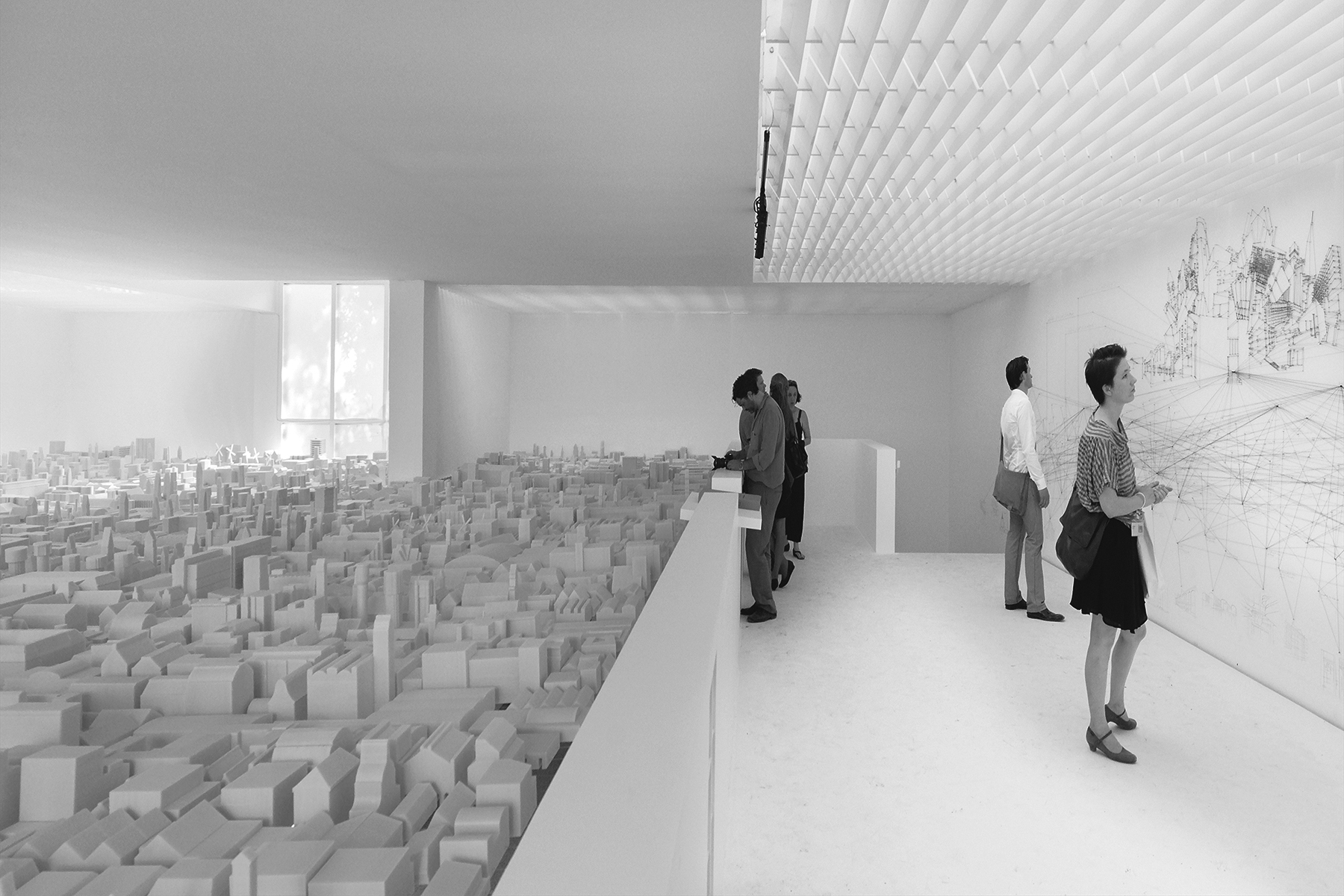
As the Chief Government Architect of The Netherlands Floris Alkemade is advising the cabinet on spatial quality, upon request or at his own initiative. He does so together with two other members of the Government Board of Advisors. Francesco Degl’Innocenti sat with him to discuss his ambitions in that role and the reach and limits of his arm. The conversation went from Mies to Mahler and from prisons to loneliness in the city.
Francesco Degl’Innocenti: How would you personally define public space?
Floris Alkemade: The space where you meet people you haven’t planned to meet.
FDI: Do you think that still exists in the Netherlands?
FA: It does, but with a different meaning at the moment: a lot of public space has become so commercialized, that its entire program seems to be about commerce. When walking down a shopping street you meet a lot of people without meeting their eyes. Currently things are changing especially in medium sized towns, where shops are closing due to the internet takeover. It’s an interesting period – cities need to redefine what public space means. Especially in Europe, historical city centers always had free public space, a function well before commerce entered as the ruling program. Those cities have to rediscover the principle of what public space is. Can public space thrive without a commercial program, simply by functioning well spatially?
FDI: So who do you think should design, maintain or even own public space, given the fact that you started by addressing the topic from commerce?
FA: As soon as public space is privately owned, different forms of exclusion become possible; the selection on who’s welcome is often based on how much people can afford to spend. Gating public spaces is a trend particularly visible in Dutch trains stations – without a train ticket you can no longer enter what has always previously been accessible to everybody. Since rail tracks historically cut the city apart, this way you also block the only connection. Trains stations are just a very painful example of separation by infrastructure, but we are witnessing a slow erosion of public space also in many government buildings – public buildings by nature – that have suddenly become inaccessible.
FDI: By 2020 the Dutch government plans to dispose of 22% of its square meter portfolio of public buildings through transformation, demolition and sale. As the State’s architecture advisor, is there a current strategy to reinvest the bump in liquidity deriving from such operations, coming from public buildings back into public space?
FA: When the government no longer needs a public building, it often want to sell it; this is too simplistic. My argument stresses that the money to finance every government building is public, therefore the sale should look beyond the economic component and into the public programming of its future function. Indeed, in terms of financial transaction this is harder to impose and organize, but we have managed to implement future public use into several projects already. Recently in Amsterdam we decided not to sell the Bijlmerbajes prison complex to the highest bidding party, but instead to institute a specific set of criteria for 50% of the evaluation, according to future public programming: money and public program were valued equally. As a government you can organize such processes and accept a lower bid if accessibility and function are guaranteed.
FDI: Could the density and the trans-municipal nature of the Randstad conurbation suggest an ecology of such tools, orchestrated by the central government?
FA: Yes, and we have established strategic collaborations with several cities. in Utrecht for instance the State owns several properties beside the central station, where the space in between public buildings is mainly parking lots. Now that the whole area is in development we proposed to the municipality to organize all mobility flows differently, in order to necessitate fewer parking spots and improve the quality of the shared surroundings. These partnerships with local administrations are based on good principles of urbanism, as much as on mutual interest.
It’s important to understand that every time the central government sells a building the local government has the priority of buying it. If the local community doesn’t have a program, then we have to approach the commercial market, with a future program as a condition. In another example the State wanted to sell an abandoned property, but due to its central position we proposed an ‘exchange program’ to specific organizations: instead of anonymous locations we offered them to move their program and activities to the center, adding to the city life, and to sell or demolish the peripheral building. In this way we can try to prevent a lack of activities in city centers and counterbalance the push toward commercial malls.
FDI: We conceived this issue of Volume from the idea that public space is shrinking under the pressure of neoliberal policies, capital and commerce…
FA: And do not forget fear: in a lot of public spaces people are excluded simply because people are somewhat afraid. Just think of all the controls to perform before entering buildings, public or private. The problem is that once something is locked it becomes very hard to make it accessible again. With every building the State transforms or constructs we try to address this by leaving the lobby open to the public. When in need of controls, they are never at the entrance. Opening a lobby is already a very emblematic statement for a public institution.
FD: Since exclusion seems to be the defining factor of present day public spaces, by contrast we can introduce the notion of civic space. Does distinguishing between the two make sense to you?
FA: How do you define the difference between public and civic space?
FDI: We imagine civic space as a synaptic space made public by the negotiation between all spatial actors. If the public space as we knew it doesn’t exist anymore and shared space has become the mediator between my ambition and someone else’s, the notion of civic space would depend entirely on time. Could this be a way to interpret the shift from public space?
FA: It is about how people can use the space, now that loneliness has become a crucial aspect of modern life – 10% of Dutch adults feel lonely and in certain neighbourhoods the figure doubles. So there’s a spatial connection with the way people live.
FDI: The UK even appointed a Minister for loneliness…
FA: Exactly, because it is not only affecting the elderly. In the Netherlands we made our cities for big families, but currently 40% of the households consist of single people: we are in a cultural transition. Informal contexts are no longer self-evident, for instance the informal interaction whilst buying something is lost in online purchases, and subsequently there are far less trips to the city. On the one hand our comfort is satisfied, but on the other the net of informal relations is reduced drastically. Although for some this seems irrelevant, for a big part of the population the effects of this slow takeover are becoming problematic. We must organize the new public space so that these informal contexts can develop naturally. In the Middle Ages people were really afraid of being alone because they believed that in solitude the devil had access to your soul. Only the most religious people dared to live secluded, since their faith was strong enough to confront Lucifer. I think there’s something valid to their belief: unwanted loneliness can have a profound effect on health even without the devil getting involved. People are social animals and still crave contact in real world/real time.

FDI: Giambattista Nolli introduced the ‘public space’ interpretation of the urban plan with its (semi)public buildings, resulting in his famous black and white maps. Benjamin Bratton introduced the notion of ‘The Stack’ to make us aware of the layered, 3D nature of spaces of information and behavior we’re surrounded by or act within. How do you visualize public space and civic space for that matter?
FA: It’s interesting that so much attention is going toward the digital world, especially through a screen: the latest data tells us that on average we stare at a screen between 400 to 650 minutes a day, out of the 1000 minutes that we spend awake. I started collecting photos of people at famous spots, like at the Vatican – everyone was working on their phone, not one person was experiencing the physical space. In another photo, no one was looking at Rembrandt’s De Nachtwacht, the most famous Dutch painting. The screen-based world is hijacking our attention, invading our space: the public space is real world and real time, and although we end up neglecting it at the moment, it also cannot be neglected. The push towards the virtual is severe in all sectors, but consequences manifest in real world/real time. Consider shopping. Now we build big boxes just to store merchandise waiting to be transported, while shops are closing in city centers. We must learn how to deal with new technologies and train ourselves to keep focus without neglecting the real world.
FDI: As national advisor on spatial matters, it seems you feel a responsibility for the virtual social space as well.
FA: Yes, and I’m fascinated by the speed. The computer ended up on our desk in the 90s, the smartphone in our pockets barely ten years ago; it reshaped our instincts inside and out, so this fascination is also worrisome. I feel responsible because it is a cultural shift in the way of thinking, and I think architecture is maybe the domain that can link the physical and virtual worlds. This could be an interesting new agenda for the architectural way of thinking.
FDI: We have started experiencing in the physical world, the unforeseeable consequences of the openness of the developments of the virtual. This reminds me of the debate in urban planning some time ago, on whether we should order and assign space by indicating what can be done at a certain spot – so nothing else – or whether we indicate what should not happen in certain areas, leaving it open for possibilities. What is your take on civic space in that respect? Defining or excluding?
FA: It comes down to what kind of control you want to have, compared to what control you actually can have. I think Mies said already in the 50s to forget about spatial planning since it is uncontrollable. As a designer this is not an easy position to take, we always want to control in order to create quality. But due to technology the gravity point is shifting: driving with a GPS device, a voice says to go left and we turn. And the voice is always right, so you don’t have to be aware of the surrounding space anymore. This means we must also change the way architecture conceives, plans and designs spaces. Whether a radical change or a more gradual one is a question we must keep asking ourselves, otherwise we end up with a sort of ‘fake space’, the bogus representation of what we already think public space ought to be. Think about all fake farms, put up just so kids can take selfies with a goat: they have nothing to do with real food production whatsoever, just a familiar representation of what we feel comfortable with. There’s no awareness of places where cows, chickens and pigs are raised by the thousands. Public space is running the same risk, becoming a comfortable manifestation of a time and culture that is no longer ours. Amsterdam is the perfect example of a city with superb public space, but where the use and the culture has radically changed, pushing the modern world into the 17th century city center. My impression is that the most intriguing things are happening in the peripheral areas of Noord, in the Bijlmermeer and all the way to Almere, where the context is not considered as perfect, so not untouchable. There is a certain sincerity that allows the emergence of new kinds of spaces. Beauty is a kiss of death.
FDI: This is the byproduct of the will to control everything that happens in public space: decades of exclusion policies have domesticated possibilities into fake space.

FA: Exactly, and this is why I love Italian cities: the level of control is still completely different, maybe even a lack thereof brings a refreshing sincerity to the space. As much as it may seem painful to see beauty underappreciated, also the composer Gustav Mahler used to say that he couldn’t make symphonies where everything sounded perfect; bits of ugliness were complementary and functional to the oeuvre. Our cities need the same. If everything is controlled and modified accordingly to look beautiful, we lose what a city should represent.
FDI: This makes me think of one peculiar type of space where control is released, the Dutch cycling network. Comparing it to similar instances such as Denmark – where every flow is neatly separated and controlled – the Netherlands decides by design to lower the degree of control at specific points. Being slightly more anarchic, it forces all agents to negotiate their spatial behavior and finally perceive the surroundings. Ever since the adoption of the first woonerf [home zone] in the 1970s, spatial awareness has been a crucial aspect of the local public space: could the bicycle path be the paradigm of Dutch civic space?
FA: This is definitely an intriguing metaphor of civic space, since cycling requires ongoing negotiation often through eyesight, not losing sense of other people. On top of that the interaction happens in movement, dynamically, which is indeed an important aspect of public space.
 This article relates to Volume #53, ‘Civic Space’.
This article relates to Volume #53, ‘Civic Space’.